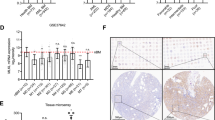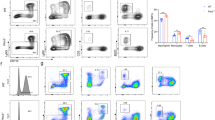Abstract
Tumor necrosis factor-related apoptosis-inducing ligand (TRAIL, APO2L) has been shown to induce apoptosis in a number of tumor cell lines as well as in some primary tumors whereas cells from most normal tissues are highly resistant to TRAIL-induced apoptosis. We have studied the susceptibility of primary malignant and normal bone marrow hematopoietic progenitors to TRAIL-induced apoptosis. Extracellular domain of human TRAIL with N-terminal His6 tag (His-TRAIL, amino acids 95–281) was produced in E. coli and its apoptosis-inducing ability was compared with the leucine-zipper containing TRAIL, LZ-TRAIL. Both variants of TRAIL had the same apoptosis-inducing ability. Clonogenic progenitor assays showed that His-TRAIL significantly reduced the number of myeloid colonies (CFU-GM) and clusters from patients with acute myeloid leukemia (AML), chronic myeloid leukemia (CML), and myelodysplastic syndromes (MDS). His-TRAIL had no negative effect on the number of CFU-GM colonies and clusters derived from bone marrow cells of AML patients in complete remission, and lymphoma patients without bone marrow involvement, as well as those derived from normal cord blood cells. Moreover, we found that normal human stem cells treated with high doses of His-TRAIL maintain a repopulating potential when transplanted into NOD/SCID mice. To conclude, our data document that TRAIL does not affect normal human hematopoiesis but suppresses the growth of early primary leukemia and myelodysplasia progenitors.
This is a preview of subscription content, access via your institution
Access options
Subscribe to this journal
Receive 12 print issues and online access
$259.00 per year
only $21.58 per issue
Buy this article
- Purchase on Springer Link
- Instant access to full article PDF
Prices may be subject to local taxes which are calculated during checkout




Similar content being viewed by others
References
Ashkenazi A, Pai RC, Fong S, Leung S, Lawrence DA, Marsters SA, Blackie C, Chang L, McMurtrey AE, Hebert A, DeForge L, Koumenis IL, Lewis D, Harris L, Bussiere J, Koeppen H, Shahrokh Z, Schwall RH . Safety and antitumor activity of recombinant soluble Apo2 ligand J Clin Invest 1999 104: 155–162
Bradbury J . TRAIL leads to apoptosis in acute promyelocytic leukaemia Lancet 2001 357: 1770
Pollack IF, Erff M, Ashkenazi A . Direct stimulation of apoptotic signaling by soluble Apo2l/tumor necrosis factor-related apoptosis-inducing ligand leads to selective killing of glioma cells Clin Cancer Res 2001 7: 1362–1369
Walczak H, Miller RE, Ariail K, Gliniak B, Griffith TS, Kubin M, Chin W, Jones J, Woodward A, Le T, Smith C, Smolak P, Goodwin RG, Rauch CT, Schuh JC, Lynch DH . Tumoricidal activity of tumor necrosis factor-related apoptosis-inducing ligand in vivo Nat Med 1999 5: 157–163
Mitsiades CS, Treon SP, Mitsiades N, Shima Y, Richardson P, Schlossman R, Hideshima T, Anderson KC . TRAIL/Apo2L ligand selectively induces apoptosis and overcomes drug resistance in multiple myeloma: therapeutic applications Blood 2001 98: 795–804
Sheridan JP, Marsters SA, Pitti RM, Gurney A, Skubatch M, Baldwin D, Ramakrishnan L, Gray CL, Baker K, Wood WI, Goddard AD, Godowski P, Ashkenazi A . Control of TRAIL-induced apoptosis by a family of signaling and decoy receptors Science 1997 277: 818–821
Kuang AA, Diehl GE, Zhang J, Winoto A . FADD is required for DR4- and DR5-mediated apoptosis: lack of trail-induced apoptosis in FADD-deficient mouse embryonic fibroblasts J Biol Chem 2000 275: 25065–25068
Miyazaki T, Reed JC . A GTP-binding adapter protein couples TRAIL receptors to apoptosis-inducing proteins Nat Immunol 2001 2: 493–500
Sprick MR, Weigand MA, Rieser E, Rauch CT, Juo P, Blenis J, Krammer PH, Walczak H . FADD/MORT1 and caspase-8 are recruited to TRAIL receptors 1 and 2 and are essential for apoptosis mediated by TRAIL receptor 2 Immunity 2000 12: 599–609
Kischkel FC, Lawrence DA, Chuntharapai A, Schow P, Kim KJ, Ashkenazi A . Apo2L/TRAIL-dependent recruitment of endogenous FADD and caspase-8 to death receptors 4 and 5 Immunity 2000 12: 611–620
Irmler M, Thome M, Hahne M, Schneider P, Hofmann K, Steiner V, Bodmer JL, Schroter M, Burns K, Mattmann C, Rimoldi D, French LE, Tschopp J . Inhibition of death receptor signals by cellular FLIP Nature 1997 388: 190–195
Sheikh MS, Burns TF, Huang Y, Wu GS, Amundson S, Brooks KS, Fornace AJ Jr, el-Deiry WS . p53-dependent and -independent regulation of the death receptor KILLER/DR5 gene expression in response to genotoxic stress and tumor necrosis factor alpha Cancer Res 1998 58: 1593–1598
Gibson SB, Oyer R, Spalding AC, Anderson SM, Johnson GL . Increased expression of death receptors 4 and 5 synergizes the apoptosis response to combined treatment with etoposide and TRAIL Mol Cell Biol 2000 20: 205–212
Wen J, Ramadevi N, Nguyen D, Perkins C, Worthington E, Bhalla K . Antileukemic drugs increase death receptor 5 levels and enhance apo-2L-induced apoptosis of human acute leukemia cells Blood 2000 96: 3900–3906
Mariani SM, Krammer PH . Surface expression of TRAIL/Apo-2 ligand in activated mouse T and B cells Eur J Immunol 1998 28: 1492–1498
Zamai L, Secchiero P, Pierpaoli S, Bassini A, Papa S, Alnemri ES, Guidotti L, Vitale M, Zauli G . TNF-related apoptosis-inducing ligand (TRAIL) as a negative regulator of normal human erythropoiesis Blood 2000 95: 3716–3724
Gazitt Y . TRAIL is a potent inducer of apoptosis in myeloma cells derived from multiple myeloma patients and is not cytotoxic to hematopoietic stem cells Leukemia 1999 13: 1817–1824
Chou AH, Tsai HF, Lin LL, Hsieh SL, Hsu PI, Hsu PN . Enhanced proliferation and increased IFN-gamma production in T cells by signal transduced through TNF-related apoptosis-inducing ligand J Immunol 2001 167: 1347–1352
Jelinek J, Neuwirtova R, Cermak J, Siskova M, Smolikova A . CFU-GM growth and survival in 258 patients with myelodysplastic syndrome Leukemia Res 1997 21: 61
Robin C, Pflumio F, Vainchenker W, Coulombel L . Identification of lymphomyeloid primitive progenitor cells in fresh human cord blood and in the marrow of nonobese diabetic-severe combined immunodeficient (NOD-SCID) mice transplanted with human CD34(+) cord blood cells J Exp Med 1999 189: 1601–1610
Petak I, Douglas L, Tillman DM, Vernes R, Houghton JA . Pediatric rhabdomyosarcoma cell lines are resistant to Fas-induced apoptosis and highly sensitive to TRAIL-induced apoptosis Clin Cancer Res 2000 6: 4119–4127
Mitsiades N, Poulaki V, Tseleni-Balafouta S, Koutras DA, Stamenkovic I . Thyroid carcinoma cells are resistant to FAS-mediated apoptosis but sensitive tumor necrosis factor-related apoptosis-inducing ligand Cancer Res 2000 60: 4122–4129
Wuchter C, Krappmann D, Cai Z, Ruppert V, Scheidereit C, Dorken B, Ludwig WD, Karawajew L . In vitro susceptibility to TRAIL-induced apoptosis of acute leukemia cells in the context of TRAIL receptor gene expression and constitutive NF-kappa B activity Leukemia 2001 15: 921–928
Jo M, Kim TH, Seol DW, Esplen JE, Dorko K, Billiar TR, Strom SC . Apoptosis induced in normal human hepatocytes by tumor necrosis factor-related apoptosis-inducing ligand Nat Med 2000 6: 564–567
Nitsch R, Bechmann I, Deisz RA, Haas D, Lehmann TN, Wendling U, Zipp F . Human brain-cell death induced by tumour-necrosis-factor-related apoptosis-inducing ligand (TRAIL) Lancet 2000 356: 827–828
de Vries EG, van der Graaf WT, Heijenbrok FJ, Hoekstra HJ, de Jong S . Don't blaze the trailblazer TRAIL too early Lancet 2000 356: 2014
Stopka T, Zivny JH, Stopkova P, Prchal JF, Prchal JT . Human hematopoietic progenitors express erythropoietin Blood 1998 91: 3766–3772
Sato T, Maekawa T, Watanabe S, Tsuji K, Nakahata T . Erythroid progenitors differentiate and mature in response to endogenous erythropoietin J Clin Invest 2000 106: 263–270
Acknowledgements
We would like to thank Dr K Michalova for providing us with clinical cytogenetic data of the patients’ cells. We also would like to thank E Mikulova, E Podzimkova, B Krasna, D Singerova and D Dyrova for outstanding technical assistance. We also thank Dr David Lynch (Immunex) for providing us with the recombinant human LZ-TRAIL. The work was supported by grants from the Grant Agency of the Academy of Sciences of the Czech Republic (A5052001), from the Internal Granting Agency of the Czech Ministry of Health (NE/6689-3), from the Grant Agency of the Czech Republic (301/00/1061, 301/99/0350), and from the Grant Agency of the Ministry of Education, Czech Republic No. VZ111100003.
Author information
Authors and Affiliations
Corresponding author
Rights and permissions
About this article
Cite this article
Plasilova, M., Zivny, J., Jelinek, J. et al. TRAIL (Apo2L) suppresses growth of primary human leukemia and myelodysplasia progenitors. Leukemia 16, 67–73 (2002). https://doi.org/10.1038/sj.leu.2402338
Received:
Accepted:
Published:
Issue Date:
DOI: https://doi.org/10.1038/sj.leu.2402338
Keywords
This article is cited by
-
Nanotechnology for the detection and kill of circulating tumor cells
Nanoscale Research Letters (2014)
-
Proteasomal regulation of caspase-8 in cancer cell apoptosis
Apoptosis (2013)
-
Establishment of reproducible xenotransplantation model of T cell acute lymphoblastic leukemia in NOD/SCID mice
Journal of Huazhong University of Science and Technology [Medical Sciences] (2012)
-
Novel second mitochondria-derived activator of caspases (Smac) mimetic compounds sensitize human leukemic cell lines to conventional chemotherapeutic drug-induced and death receptor-mediated apoptosis
Investigational New Drugs (2011)
-
Regulatory functions of TRAIL in hematopoietic progenitors: human umbilical cord blood and murine bone marrow transplantation
Leukemia (2010)



